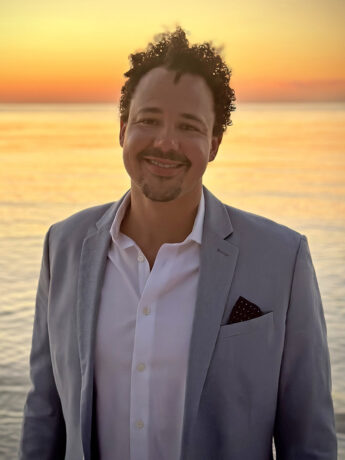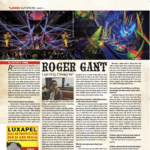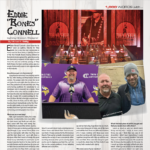
André Petrus started lighting shows at 15 in high school. After graduating Full Sail University, he moved to Nashville and started his professional career at 19. He quickly moved his way through rental shops, out on the road as a lighting tech, before moving on to lighting directing. In 2016 he moved to being a full time Lighting Programmer. Since then, he’s worked in television and live concerts working with artist such as: Shania Twain, Nick Jonas, Demi Lovato, Tim McGraw, Faith Hill, Kelsea Ballerini, Drake, Little Big Town, Lana Del Rey, G-Eazy, Halsey, Old Dominion, Zac Brown Band, Panic at the Disco, Burna Boy, Charlie Puth, J Balvin, Rihanna, Queen, Greta Van Fleet, and Lil Nas X. I caught up with Petrus on a break, from programming an upcoming mega tour, to discuss his career path.
How did you get into the industry?
What got me interested in production was that I grew up in a megachurch. The services were way too long; and as a kid, I honestly hated going. The thing about our church was, it was televised. I was so intrigued by the cameras, that my parents signed me up to volunteer for the video crew. Next thing, I was 12 years old running a camera. I originally wanted to be a director. Then I went to a high school with a brand new theater, and I took a set design class freshman year where I learned about lighting, audio, and the other departments in production. I fell in love with lighting. When I went to my first concert, I realized that lighting is a whole career.
I started lighting at 15 and became a student technical director at the school. I did online research on who designed concerts and then reached out to some of them; some would even invite me out to their shows. They talked to me and mentored me. I went to Full Sail, and when I graduated at 19, moved to Nashville, and got my first job at Bandit Lites.
My first time on the road was as the sixth man on the lighting crew for Taylor Swift’s Fearless Tour in 2009. I did one tour with her, and then I was picked up by the opening act, Kelly Pickler, as her Lighting Director. It just kept going from there. One tour led to another and to another, until I eventually became a full-time programmer. I’ve been doing that since 2016.
And now you are making the switch over to designing.
I am, to be honest. But at the same time, I’m very careful when saying that because I still have a lot of good designer clients. I’ve always let things happen organically. When the opportunity and the doors open, I take them. But I don’t go out and solicit work. I just never say no to an opportunity.

What would you consider one or two milestones in your career?
I would say the first time working with Shania being the first milestone, being a lighting director on such a large-scale tour. The next would be meeting Lighting Director Mark Carver in 2016 on the CMA Fest. He taught me so much about television lighting, which I now do a lot of as well. I was a Key Light Programmer, and Mike Swinford was the Designer. After that, Mark asked me to do the Dove Awards with him, which I’ve been doing since 2016. He taught me so many things I didn’t know that I didn’t know. We’ve done countless award shows and TV specials at this point. Meeting him was another milestone. Every year feels like a milestone, to be honest with you.
What do you enjoy most about your career?
I enjoy being creative. Being able to be creative, and be my own boss is my dream. Being able to make a living doing what you love has been such a blessing and almost hard to fathom. This is all I’ve ever done, my whole life. I’m 34 now, so literally, all I know is this world.
This past year there’s been a lot of new opportunities and new conversations with people that I haven’t been able to have before. I feel like I’ve finally reached a point of mutual respect. I look back and yes, I’m still young, but I’ve been doing this for a while now. At the end of the day, it’s years of experience. Sometimes it’s hard to say that being young, but I’ve literally been behind consoles for a long time now—the majority of my life as a part of shows and productions of all sizes.
Who else has been a mentor for you?
In addition to Mark Carver, I’d say the influences that have played a key role in my career include Scott Holthaus, Jesse Blevins, George Jackson, Johnathan Smeeton, Butch Allen, Mark Butts, Sooner Routhier, and Rob Sinclair. I met Jesse Blevins back when I was 15 at a Gwen Stefani show. I was so hungry to learn more and to talk to people that I’d buy a cheap ticket and make my way to front of house and just talk to people. We exchanged numbers and he mentored me through the years. He gave me advice and invited me out to shows that he worked on. He finally asked me to do some shows for him, and we still collaborate on projects. Another key person was Scott Holthaus with Red Hot Chili Peppers. He invited me out to a show when I was 16. At that point I decided this is literally what I was meant to do.
Is there a piece of advice you got at the start of your career you still find applicable today?
I don’t know if anybody told me this, but I would say I learned ‘keep my mouth shut, my head down, and learn.’ Just do the job and do it to the best of your ability.
What advice would you give to someone in the early stage of their career?
I would say don’t jump the gun. Learn the craft before you think you can do it all. To this day, I’m still learning and figuring things out. Just let things happen naturally. Don’t force things. Another big piece of advice is invest well and live below your means. Because, it’s not going to last forever, and you’ve got to take care of yourself for later. You’ll want the ability to not have to do this your whole life.
What surprised you most about your career path?
I feel like I’m doing exactly what I’m meant to do, to be honest. I had this vision when I was young, and I’m living it out to this day. I will say that I work harder now than I did earlier. I’m gone away from home more now than when I was touring. When you’re in rehearsals, you’re usually not rehearsing where you live. When you go from one rehearsal to another rehearsal, you’re always on the move. There’s absolutely no rhythm. So, the chaos of production rehearsals is my life every day.
That’s one thing that I think that people misunderstand; they think ‘oh, it must be so nice to be a programmer or designer because you do a project, and you have time off.’ To be honest, I don’t. Usually, it goes from one to the other. It’s always chaotic, always nonstop work. There’s no rhythm like you would if you were on tour. What keeps me going is the fact that it might be hell for three or four weeks, but there’s an end date. A start date and an end date. I think that is one of the things that gets me through the chaotic schedule.


